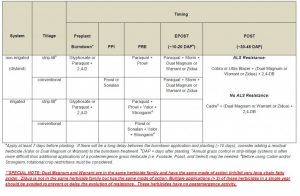Dusting in cotton is never a great option. Our highest yields in cotton have always been with cotton planted by May 31. One way to get the crop in during dry conditions is to dust in cotton really shallow (1/2 inch or less). The idea is to just cover seed with soil with the hope that a light rain will make seed germinate and give an adequate stand. Make sure the soil is dry. If moisture is there then seed can actually swell, but not have enough moisture to germinate leading to seed rotting. It’s a decision each farmer has to make. If you only have a few acres left to finish, you may be able to wait on a rain. However, if you have over 1,000 acres to plant, you can’t afford to wait.
Weed control and using herbicides with shallow planted cotton can be problematic. Normally, we want the seed to germinate and grow before the herbicide is completely activated limiting the damage. In dry conditions this nearly impossible.
- Reflex moves very effectively in water thus it is the product most likely to reach the seed at higher concentrations. Although that is not beneficial for the cotton seed, it is very beneficial for weed control as the product is activated more effectively with lower amounts of rainfall or irrigation than other cotton herbicides. Additionally, our research has shown Reflex to sit on the soil for 17 days before being activated and then still providing about 90% control of the pigweed emerging after activation.
- Warrant poses a unique challenge, if the encapsulation breaks down releasing the active ingredient prior the cotton plant emerging then injury can be quite significant. It is the encapsulation of Warrant that provides us the ability to use it “safely” PRE in cotton. Any time one is uncertain of cotton emergence within 5 or 6 days of applying Warrant, one may want to consider other options. Ideally Warrant needs around a half inch of rain for activation and our research has shown it to still be quite effective on pigweed after sitting on the soil and waiting 11 days for activation.
- Diuron will move down to the seed less aggressively than Reflex, but if a heavy rain occurs within a few days of dusting the cotton in and applying diuron, injury will be much greater than normal.
- Brake likely poses the least damage potential to cotton in this environment, but the herbicide may not perform on weeds properly until a half inch or more of rainfall occurs.
Things to consider:
Be sure there are no weeds present when cotton is planted in dry soil. Other weeds should not emerge until it rains.
Once cotton is fully emerged the first postemergent herbicide application should be made. The treatment should be made when pigweed are small enough to achieve a 100% kill. Don’t wait until you see them from the road. Also, include a residual herbicide in the application.
14 to 18 days after the first postemergent herbicide the second postemergence herbicide application should be made and again include a residual product.
Last, the layby application should include conventional herbicide chemistry such as diuron, Caparol or Cotoran; and include Envoke if help is needed with morningglory or nutsedge.
Gramoxone on peanuts in dry weather. Should you do it?
I’ve been getting a lot of questions on whether or not to use the typical gramoxone burn down treatment on dryland peanuts under the current dry conditions. Obviously, the drier it is the greater the chance of injury and yield loss. The old saying, “if it don’t rain it don’t matter” applies here.
Below are some peanut herbicide considerations from Dr. Prostko:
- If you have started clean, used a strong residual herbicide program that includes Prowl or Sonalan + Valor, and that residual program was activated with a timely rainfall or irrigation event, there is a VERY strong chance that there will be no need for a “cracking” application of paraquat. I see no need to torch a peanut field if weeds are not present.
- Applications of paraquat alone should be applied at 5.5 oz/A (3 lb ai/gal) or 8 oz/A (2 lb ai/gal) up until 14 days after cracking (DAC). Include a NIS @ 0.25% v/v (1 qt/100 gal).
- When applied at higher rates, later than 14 DAC, and/or in combination with a residual herbicide (Dual Magnum, Warrant, or Zidua), use a safener (Basagran or Storm). Safeners have 2 functions. They slightly reduce the foliar injury caused by paraquat and help improve the control of other weeds, especially smallflower morningglory (Figure 2).
- UGA recommended use rates for tank-mixtures are as follows: Paraquat @ 8 oz/A (3 lb ai/A) or 12 oz/A (2 lb ai/A) + Dual Magnum @ 16 oz/A or Warrant @ 48 oz/A or Zidua @ 1.5 oz/A (dry)/2.5 oz/A (liquid) + Basagran @ 8 oz/A or Storm @ 16 oz/A. When using Warrant or Zidua include a NIS @ 0.25% v/v (1 qt/100 gal) (Figure 3).
- Apply paraquat mixtures in 15 GPA, use pressure/nozzle combinations that result in the delivery of medium droplets (236-340 microns), and slower tractor speeds. With medium size droplets, spray coverage is improved at slower tractor speeds. Additionally, slower tractor speeds will reduce the formation of dust which can adversely influence the performance of paraquat.
- Avoid paraquat applications after 28 days after cracking.
